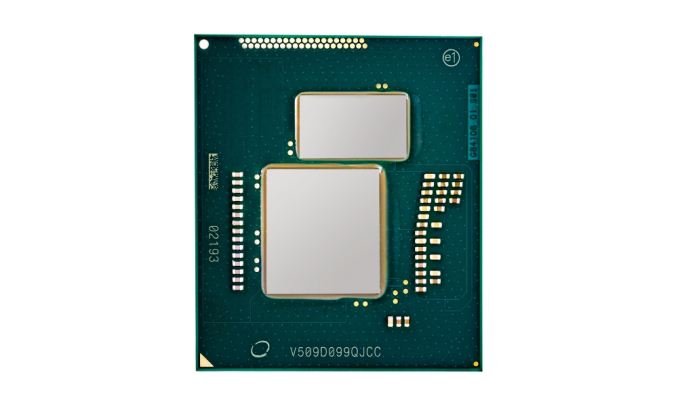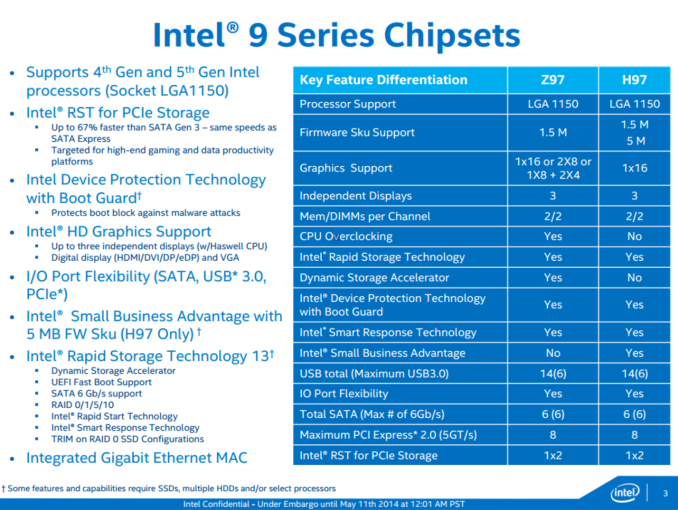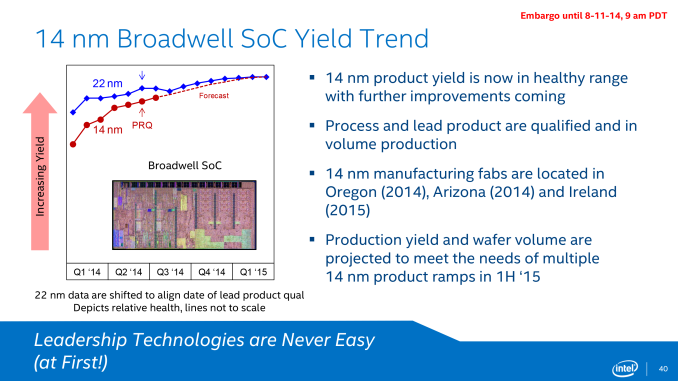The Intel Broadwell Desktop Review: Core i7-5775C and Core i5-5675C Tested (Part 1)
by Ian Cutress on June 2, 2015 7:45 AM ESTThe SKUs
While today's release doesn't preclude Intel from releasing additional Broadwell-DT processors in the future, for now here is what the starting lineup of five 65W SKUs looks like.
| Intel 65W Broadwell-DT Lineup | |||||
| i7-5775C | i7-5775R | i5-5675C | i5-5675R | i5-5575R | |
| Price | $366 | $348 | $276 | $265 | $244 |
| Cores | 4 | 4 | 4 | 4 | 4 |
| Threads | 8 | 8 | 4 | 4 | 4 |
| Base CPU Freq. | 3.3GHz | 3.3GHz | 3.1GHZ | 3.1GHZ | 2.8GHZ |
| Turbo CPU Freq. | 3.7GHz | 3.8GHz | 3.6GHz | 3.6GHz | 3.3GHz |
| Graphics | Iris Pro 6200 (GT3e) | Iris Pro 6200 (GT3e) | Iris Pro 6200 (GT3e) | Iris Pro 6200 (GT3e) | Iris Pro 6200 (GT3e) |
| EUs | 48 | 48 | 48 | 48 | 48 |
| iGPU Freq. | 1150MHz | 1150MHz | 1100MHz | 1100MHz | 1050MHz |
| TDP | 65W | 65W | 65W | 65W | 65W |
| DRAM Freq. (DDR3L) |
1600MHz | 1600MHz | 1600MHz | 1600MHz | 1600MHz |
| L3 Cache | 6MB | 6MB | 4MB | 4MB | 4MB |
| L4 Cache | 128MB (Crystal Well) | 128MB (Crystal Well) | 128MB (Crystal Well) | 128MB (Crystal Well) | 128MB (Crystal Well) |
| Interface | LGA | BGA | LGA | BGA | BGA |
Those with R at the end will be soldered down BGA parts, similar to the mobile Haswell-H models featuring Crystal Well. The two ‘C’ models will be socketed LGA parts, meaning that with a BIOS upgrade should be compatible in all Z87 and Z97 motherboards.
As for pricing, Intel's prices are fairly consistent with what they have been charging over the Haswell generation. The top-tier i7-5775C will fetch $366, a bit over the list price of the i7-4790K, but only about $10 off of the list price of the top Haswell Crystal Well part, i7-4770R. Otherwise the soldered counterpart to the i7 family, the i7-5775R, will go for a bit less at $348.
Below that we have the i5 family. The socketed i5-5675C will go for $276, which happens to be the same list price as the Crystal Well equipped i5-4670R, or $34 more than i5-4670K. Below that we have the last two soldered parts, the $265 i5-5675R, and the $244 i5-5575R.
Ultiamtely it goes without saying that none of these processors will be especially cheap, however with 128MB of eDRAM on-board we weren't necessarily expecting them to be, either. However what this also means is that Intel might take the iGPU crown from AMD, but it will come at nearly 3x the cost.
Broadwell-K, or is it Broadwell-C, or Broadwell-H?
In recent generations, Intel’s overclocking processors have all been given the K designation except the Pentium G3258 which is a special edition model celebrating Pentium’s 20th birthday (but affectionately called Pentium-K). Naturally then we assumed that even though we knew there would be Broadwell processors with Crystal Well, that any overclockable SKUs would be given the K name. But this is not the case, and as a result we have to deal with another identifier in Intel’s product stack. Thankfully, C for Crystal Well is somewhat obvious, although it avoids the overclocking element.
Intel’s other Crystal Well parts, those on Haswell that are for laptops and the three others in todays launch, are all called R. We’re still not sure why they are called R, but now we have Crystal Well with R and C. Something tells me that it might have been easier to call the socketed ones i7-RK, but would you believe it Intel is already using RK for its Atom x3 chip agreement with Rockchip. That leaves i7-CK as a potential, although many users will still call them Broadwell-K, just for ease of use. Intel internally wants to differentiate the K product line from the Crystal Well products, although adding overclocking to the new socketed processors confuses that mix.
Chipset Compatibility
The Broadwell processors will use the LGA1150 socket, which is currently found on all 8-series and 9-series chipsets. Based on our own internal testing, users should wait until a BIOS for their motherboard is available that officially supports the new processors. In our testing, putting in the CPU without the BIOS caused random freezing and the integrated graphics to fail on simple things such as navigating Chrome. It is also worth mentioning that early BIOSes might not allow overclocking, and this is primarily the reason why we are saving overclocking for another review.
On that note, motherboard manufacturers will typically put out a press release when a new CPU arrives to announce support on at least their major motherboards. Normally this press release appears before the official launch. That being said, similar to the Devil’s Canyon launch, we expect CPUs to be available towards the end of the month at the earliest, rather than on the shelves today.
The Reality
When I read about some of Intel’s plans with Broadwell-DT, I was confused. We are so used to having two sets of processors launched per socket with Intel, covering the complete range from Celerons at the bottom up to i7-K models at the top. Not having a wide range of processors this time will raise question marks, especially for those that want to upgrade to a Broadwell CPU. But I have sat for a while and racked my brains. This is what I have come with.
We all recognize that Intel’s 14nm process was late in getting acceptable yields and is also quite expensive in its own right. To that end, Intel started with the small dies before it moved up to the bigger quad-core ones for desktop and mobile, which given the prevelence of quad-cores in desktop SKUs (virtually the entire i5 and i7 ranges) delayed the desktop release even further. There has been much speculation as to when Skylake will come to market, as if I recall correctly Intel wants to keep to Moore’s Law as much as possible, and that means releasing Skylake at some point in 2015.
To that end, Broadwell-DT is a stop-gap to Skylake. In a stop-gap, you do not release a whole stack, because you end up annoying those who invest and then realise the next thing is just about to be released. So you have to release something interesting that will get interest or target a non-regular crowd. That crowd, by virtue of my comments earlier up the page, is those interested in integrated graphics and Crystal Well. Stick in some eDRAM, make it overclockable, and if you can take the integrated graphics crown from AMD, even better. Users who want peak integrated performance will invest, those wanting peak anything else will buy the greatest which might afford more profit or at least keep the investors happy. It also means that there will not be a massive amount of stock in the channel, so once the stop-gap's replacement is here, the stop-gap can quickly be shifted to End-Of-Life (EOL).
Did that make sense? The comment about EOL is an interesting one, as I have heard rumors from other technology media that they are expecting Broadwell-DT to be put into EOL relatively quickly. However, we can’t confirm this.
The Purpose of This Review
We were able to source both the i7-5775C and the i5-5675C to test, along with a reasonably updated BIOS but right around the time Computex was about to start. A combination of time and firmware means that this review will focus on stock performance, comparing it to other processors in its price range. We also had initial issues with testing the graphics, and due to time constraints again we only have IGP results for the i5, but also we only have Linux tests for the i7. But aside from that we were able to test both CPUs in our regular testing suite and have almost 200 data points between the two for comparison. One of my personal focal points was to retest the Crystal Well implementation for CPU performance, but this time we also get to test it with discrete graphics cards as well.













196 Comments
View All Comments
Shadowmaster625 - Tuesday, June 2, 2015 - link
Wow so anyone who buys one of these chips is spending half their money on a useless GPU that cant even beat a lowly R7 250. That is $120 to $180 totally wasted on GPU, which occupies half the die. Talk about a massive intel tax. What happens if intel only offer a K version that contains half the die wasted by this useless GPU? How many people are going to just suck it up and buy it even though half the chip will never be used because they will be running a real graphics card?TEAMSWITCHER - Tuesday, June 2, 2015 - link
These chips really only make sense for high end laptops like the 2015 MacBook Pro - which ironically doesn't use them. It boggles my mind that Intel is shipping so many transistors that go completely unused. It's the antithesis of Moore's Law - Intel silicon is HALF-USELESS.PubFiction - Wednesday, July 1, 2015 - link
That's because intel only cares about mobile now, this stuff isn't made for us its hacked to work for desktop users this stuff is all about mobile. Personally I deal with largely because I am just happy that people who buy stuff like macbooks can now actually have a chance of running boot camp and playing games. In the mobile work igpus have always been a big part of the scene. Also the better intel does with integrated graphics the more they are able to kill AMD/NVidia which is what they really want to do, slowly and steadily eat the bottom end of the GPU market out from under them. It used to be that ANY discreet graphics on a laptop was WAYYYYY better than integrated. But after intels 2nd gen core series the bottom X1XX and X2XX gpus seemed to not make any sense, and intel has been getting better to the point now that X4XXX gpus are starting to not make sense. This screws graphics makers into only being able to sell higher end X5XX + GPUs and they destroys their bread and butter money.bill.rookard - Tuesday, June 2, 2015 - link
As much as I hate to say it, I agree. While their new iGPU is beating AMDs iGPU, the place where such iGPUs make sense is in small HTPC scenarios most of all (apart from budget gaming laptops which have a completely different thermal restriction). The kicker is though that the pricing is far too high for even being considered for what amounts to a media playback machine. It's thermally too hot for a laptop scenario.If they had paired up the iGPU with a G3258 CPU core set and the Crystalwell DRAM, and priced it near AMD's offerings, THAT would be a very compelling product.
Refuge - Tuesday, June 2, 2015 - link
I'd buy that.extide - Tuesday, June 2, 2015 - link
Uhhh, maybe you need your eyes checked, but it is beating the R7 240 in all except one of the benchmarks...MikhailT - Tuesday, June 2, 2015 - link
Dude, go re-read the graphs, Intel is beating R7 in almost all benchmarks.Namisecond - Wednesday, June 3, 2015 - link
Actually, the GPU takes up over 60% of the die space on the first chips, there is a 2nd piece of silicon comprising the EDRAM that take up a not-so-insignificant piece of real estate on the chip.The situation with AMD APUs are similar, about 40-45% of their die space is GPU. When they go HBM, they will in a similar situation to Intel, and they'll need to charge much higher price to make up for the tech.
If you want lowest cost/value for CPU, get a Pentium, particularly the anniversary edition. They're cheap (I can get them for about $50) You can overclock the shit out of them and their IGPU only takes up about 40% of their die space. If you need more CPU power in the Socket 1150 format, get a Xeon E3 which has no IGPU...they are cheaper than Core I7, but they cost more than core I5.
der - Tuesday, June 2, 2015 - link
Awesome stuff! Killer chipset!der - Tuesday, June 2, 2015 - link
50th comment!